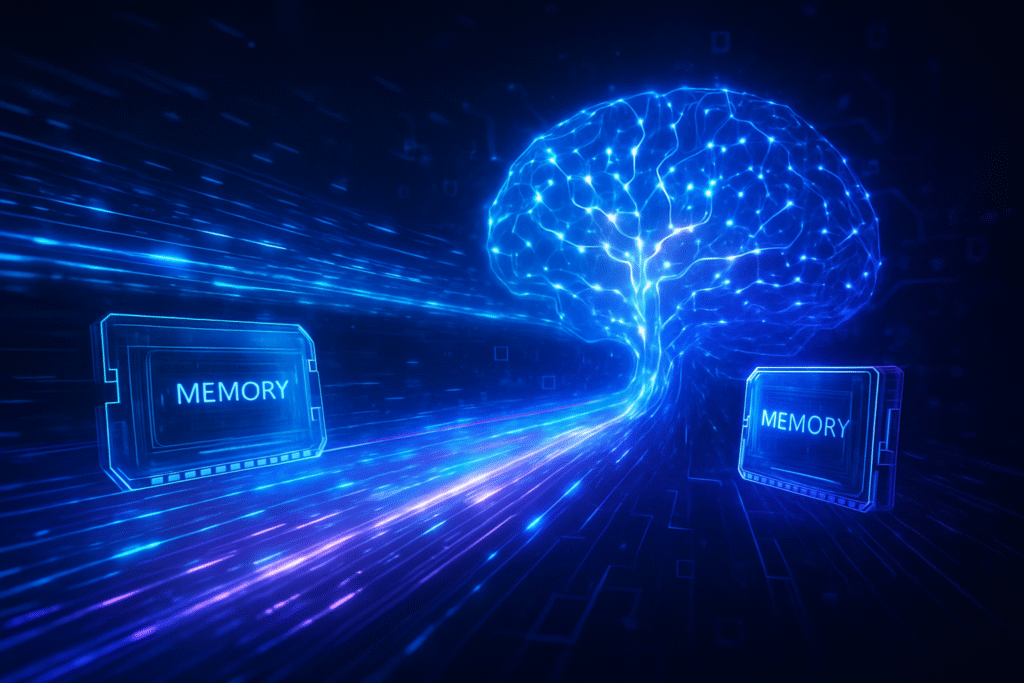
The relentless pursuit of more powerful and efficient artificial intelligence (AI) systems is driving innovation across every facet of computing, and memory technology stands at the forefront of this revolution. The advent of next-generation DDR5 and LPDDR5 memory standards marks a pivotal moment, offering unprecedented advancements in bandwidth, capacity, and power efficiency. These new memory architectures are not merely incremental upgrades; they are foundational enablers designed to shatter the "memory wall," a long-standing bottleneck that has constrained the performance of data-intensive AI workloads. Their immediate significance lies in their ability to feed the insatiable data hunger of modern AI models, from massive language models to complex computer vision systems, both in the sprawling data centers and on the burgeoning intelligent edge.
As AI models grow exponentially in complexity and size, demanding ever-increasing amounts of data to be processed at lightning speeds, the limitations of previous memory generations have become increasingly apparent. DDR5 and LPDDR5 address these critical challenges head-on, providing the necessary infrastructure to accelerate AI model training, enhance real-time inference capabilities, and facilitate the deployment of sophisticated AI on power-constrained devices. This leap forward is poised to redefine what's possible in AI, unlocking new frontiers in research, development, and application across a multitude of industries.
A Deep Dive into the Technical Revolution
DDR5 (Double Data Rate 5) and LPDDR5 (Low-Power Double Data Rate 5) represent a significant architectural overhaul from their predecessors, DDR4 and LPDDR4, respectively. The core objective behind these advancements is to provide more data faster and more efficiently, a non-negotiable requirement for the escalating demands of AI.
DDR5, primarily targeting high-performance computing, enterprise servers, and data centers, boasts a substantial increase in bandwidth. Initial transfer rates are 50% higher than DDR4, with speeds reaching up to 7200 MT/s and beyond, effectively doubling the bandwidth of its predecessor. This enhanced throughput is critical for AI model training, where vast datasets, including high-resolution images and video, must be rapidly loaded and processed. DDR5 also supports higher memory capacities per module, enabling larger models and datasets to reside in faster memory tiers, reducing reliance on slower storage. While DDR5 typically exhibits higher Column Address Strobe (CAS) latency compared to DDR4 due to its increased clock speeds, its much higher bandwidth often compensates for this, especially in the bulk data transfers characteristic of AI training. Furthermore, DDR5 operates at a lower voltage (1.1V vs. 1.2V for DDR4), leading to improved power efficiency and reduced heat generation, crucial for dense, high-performance AI environments.
LPDDR5, on the other hand, is specifically engineered for mobile, embedded, and edge AI applications where power efficiency and a compact form factor are paramount. LPDDR5 and its extensions, such as LPDDR5X (up to 8.533 Gbps) and LPDDR5T (up to 9.6 Gbps), offer significantly increased data rates and bandwidth compared to LPDDR4X. This high throughput, coupled with optimizations like advanced command processing and bank management, minimizes latency, which is vital for on-device AI inference. LPDDR5's most distinguishing feature is its exceptional power efficiency, achieved through lower operating voltages, dynamic voltage and frequency scaling (DVFS), and intelligent power optimization algorithms. It can be up to 20% more power-efficient than LPDDR4X, making it the ideal choice for battery-powered devices like smartphones, IoT gadgets, and autonomous vehicles running sophisticated AI models. The compact design of LPDDR5 also allows for multi-die packaging, supporting capacities up to 64GB, addressing the growing memory needs of advanced edge AI applications.
The initial reactions from the AI research community and industry experts have been overwhelmingly positive. Researchers are particularly excited about the potential to accelerate the training of even larger and more complex neural networks, reducing computational time and resources. Industry experts emphasize that these memory standards are not just about raw speed but about creating a more balanced system, where the processing power of CPUs and GPUs is not bottlenecked by slow data access. The seamless integration of DDR5 with technologies like Compute Express Link (CXL) is also garnering attention, promising elastic scaling of memory resources across various accelerators, further optimizing AI workloads.
Reshaping the AI Competitive Landscape
The widespread adoption of DDR5 and LPDDR5 memory standards is poised to significantly impact AI companies, tech giants, and startups alike, reshaping the competitive landscape and driving new waves of innovation. Companies that can effectively leverage these memory advancements will gain substantial strategic advantages.
Semiconductor manufacturers like Samsung (KRX: 005930), SK Hynix (KRX: 000660), and Micron Technology (NASDAQ: MU) are at the forefront, investing heavily in the development and production of these new memory modules. Their ability to deliver high-performance, high-capacity, and power-efficient DDR5 and LPDDR5 at scale will directly influence the pace of AI innovation. These companies stand to benefit immensely from the increased demand for advanced memory solutions across the AI ecosystem.
Cloud providers and data center operators, including Amazon (NASDAQ: AMZN) with AWS, Microsoft (NASDAQ: MSFT) with Azure, and Alphabet (NASDAQ: GOOGL) with Google Cloud, are rapidly upgrading their infrastructure to incorporate DDR5. This allows them to offer more powerful and cost-effective AI training and inference services to their clients. The enhanced memory bandwidth means faster job completion times for AI workloads, potentially leading to reduced operational costs and improved service offerings. For these tech giants, integrating DDR5 is crucial for maintaining their competitive edge in the fiercely contested cloud AI market.
AI hardware developers, particularly those designing AI accelerators, GPUs, and specialized AI chips, will find DDR5 and LPDDR5 indispensable. Companies like NVIDIA (NASDAQ: NVDA) and AMD (NASDAQ: AMD), whose GPUs are central to AI training, will see their architectures become even more potent when paired with DDR5. Similarly, developers of edge AI processors, such as Qualcomm (NASDAQ: QCOM) and MediaTek (TPE: 2454), will rely on LPDDR5 to deliver sophisticated AI capabilities to mobile devices, autonomous vehicles, and IoT endpoints without compromising battery life or thermal envelopes.
AI startups and research labs will also benefit significantly. Access to systems with DDR5 and LPDDR5 will democratize access to high-performance computing, enabling smaller entities to conduct more ambitious research and develop more complex AI models without requiring prohibitively expensive, custom hardware solutions. This could lead to a surge in innovation, as the barrier to entry for certain computationally intensive AI tasks is lowered.
The competitive implications are clear: companies that are slow to adopt or integrate these new memory standards risk falling behind. Existing products or services that rely on older memory technologies may face disruption as competitors offer superior performance and efficiency. Market positioning will increasingly hinge on the ability to harness the full potential of DDR5 and LPDDR5, translating into strategic advantages for those who lead the charge in their implementation.
The Wider Significance in the AI Landscape
The emergence and rapid adoption of DDR5 and LPDDR5 memory standards fit seamlessly into the broader AI landscape, acting as crucial accelerators for several overarching trends. They are fundamental to the continued scaling of large language models (LLMs), the proliferation of generative AI, and the expansion of AI into ubiquitous edge devices.
These memory advancements directly address the "memory wall" problem, a significant bottleneck where the speed of data transfer between the processor and memory lags behind the processing capabilities of modern CPUs and GPUs. By breaking through this wall, DDR5 and LPDDR5 enable more efficient utilization of computational resources, leading to faster training times for complex AI models and more responsive inference engines. This is particularly vital for generative AI, which often involves processing and generating massive amounts of data in real-time. The ability to handle larger datasets and model parameters in memory also means that more sophisticated AI models can be developed and deployed without constant disk I/O, which is inherently slower.
The impacts extend beyond raw performance. LPDDR5's exceptional power efficiency is critical for the sustainable growth of AI, particularly at the edge. As AI moves from the cloud to personal devices, vehicles, and smart infrastructure, power consumption becomes a paramount concern. LPDDR5 enables powerful AI capabilities to run on battery-powered devices for extended periods, making "AI everywhere" a practical reality. This also contributes to reducing the overall energy footprint of AI, an increasingly important consideration as the environmental impact of large-scale AI operations comes under scrutiny.
Comparing this to previous AI milestones, the memory advancements can be seen as analogous to the leaps in GPU computing that revolutionized deep learning a decade ago. Just as powerful GPUs unlocked the potential of neural networks, DDR5 and LPDDR5 are unlocking the full potential of these GPU-accelerated systems, ensuring that the processing power is not wasted waiting for data. While not a breakthrough in AI algorithms itself, it is a critical infrastructural breakthrough that enables algorithmic advancements to be realized more effectively. Concerns, however, include the initial cost of adopting these new technologies and the potential for increased complexity in system design, especially when integrating with emerging technologies like CXL. Nevertheless, the consensus is that the benefits far outweigh these challenges.
Charting the Course: Future Developments
The journey for DDR5 and LPDDR5 is far from over, with numerous exciting developments expected in the near-term and long-term. These memory standards are not static; they are evolving to meet the ever-increasing demands of AI.
In the near term, we can anticipate further increases in clock speeds and bandwidth for both DDR5 and LPDDR5, with new iterations like LPDDR5T already pushing boundaries. Manufacturers are continuously refining fabrication processes and architectural designs to extract more performance and efficiency. We will also see broader adoption across all computing segments, from mainstream consumer devices to high-end servers, as production scales and costs become more competitive. The integration of DDR5 with emerging memory technologies and interconnects, particularly Compute Express Link (CXL), will become more prevalent. CXL allows for memory pooling and disaggregation, enabling dynamic allocation of memory resources across CPUs, GPUs, and specialized AI accelerators, thereby optimizing memory utilization and reducing latency for complex AI workloads.
Looking further ahead, potential applications and use cases on the horizon are vast. Enhanced memory performance will facilitate the development of even larger and more sophisticated AI models, pushing the boundaries of generative AI, multimodal AI, and truly intelligent autonomous systems. Real-time AI inference in edge devices will become more robust and capable, powering advanced features in augmented reality (AR), virtual reality (VR), and personalized AI assistants. We might see new memory-centric computing architectures emerge, where memory itself becomes more intelligent, performing certain pre-processing tasks closer to the data, further reducing latency.
However, challenges remain. The increasing complexity of memory controllers and interfaces requires continuous innovation in chip design. Thermal management will also be a persistent challenge as memory densities and speeds increase. Furthermore, balancing performance, power, and cost will always be a critical consideration for widespread adoption. Experts predict that the next few years will see a consolidation of these memory technologies as the industry settles on optimal configurations for various AI use cases. The synergy between high-bandwidth memory (HBM), DDR5/LPDDR5, and other memory tiers will become increasingly important in creating hierarchical memory architectures optimized for AI workloads.
A New Era of AI Performance
The introduction and rapid adoption of DDR5 and LPDDR5 memory standards represent a profound shift in the technological underpinnings of artificial intelligence. The key takeaways are clear: these new memory generations deliver unprecedented bandwidth, higher capacities, and significantly improved power efficiency, directly addressing the critical "memory wall" bottleneck that has long constrained AI development. DDR5 empowers data centers and high-performance computing environments to accelerate AI training and large-scale inference, while LPDDR5 is the essential enabler for the pervasive deployment of sophisticated AI on power-constrained edge devices.
This development's significance in AI history cannot be overstated. While not an algorithmic breakthrough, it is a crucial hardware advancement that empowers and amplifies every algorithmic innovation. It is akin to laying down wider, faster highways for the burgeoning traffic of AI data, allowing existing AI "vehicles" to travel at unprecedented speeds and enabling the creation of entirely new, more capable ones. The ability to process more data faster and more efficiently will undoubtedly accelerate the pace of AI research and deployment, leading to more intelligent, responsive, and power-efficient AI systems across all sectors.
Looking ahead, the long-term impact will be a more democratized and ubiquitous AI. As memory becomes faster and more efficient, the cost-performance ratio for AI workloads will improve, making advanced AI capabilities accessible to a broader range of businesses and applications. We can expect a continued push towards higher speeds and greater capacities, alongside deeper integration with emerging memory technologies like CXL. What to watch for in the coming weeks and months includes further announcements from semiconductor manufacturers regarding next-generation modules, benchmarks showcasing real-world performance gains in AI applications, and the increasing incorporation of these memory standards into new server platforms, mobile devices, and AI accelerators. The future of AI is intrinsically linked to the evolution of memory, and with DDR5 and LPDDR5, that future looks exceptionally bright.
This content is intended for informational purposes only and represents analysis of current AI developments.
TokenRing AI delivers enterprise-grade solutions for multi-agent AI workflow orchestration, AI-powered development tools, and seamless remote collaboration platforms.
For more information, visit https://www.tokenring.ai/.






